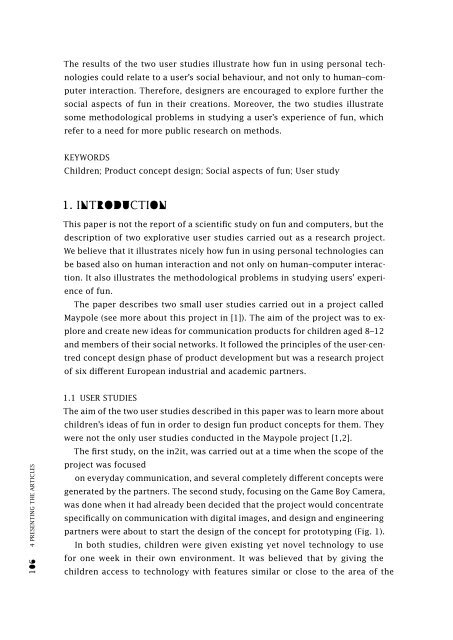Co-experience: Understanding user experiences in social interaction
Co-experience: Understanding user experiences in social interaction
Co-experience: Understanding user experiences in social interaction
Create successful ePaper yourself
Turn your PDF publications into a flip-book with our unique Google optimized e-Paper software.
The results of the two <strong>user</strong> studies illustrate how fun <strong>in</strong> us<strong>in</strong>g personal technologies<br />
could relate to a <strong>user</strong>’s <strong>social</strong> behaviour, and not only to human–computer<br />
<strong>in</strong>teraction. Therefore, designers are encouraged to explore further the<br />
<strong>social</strong> aspects of fun <strong>in</strong> their creations. Moreover, the two studies illustrate<br />
some methodological problems <strong>in</strong> study<strong>in</strong>g a <strong>user</strong>’s <strong>experience</strong> of fun, which<br />
refer to a need for more public research on methods.<br />
KEYWORDS<br />
Children; Product concept design; Social aspects of fun; User study<br />
1. INTRODUCTION<br />
This paper is not the report of a scientific study on fun and computers, but the<br />
description of two explorative <strong>user</strong> studies carried out as a research project.<br />
We believe that it illustrates nicely how fun <strong>in</strong> us<strong>in</strong>g personal technologies can<br />
be based also on human <strong>in</strong>teraction and not only on human–computer <strong>in</strong>teraction.<br />
It also illustrates the methodological problems <strong>in</strong> study<strong>in</strong>g <strong>user</strong>s’ <strong>experience</strong><br />
of fun.<br />
The paper describes two small <strong>user</strong> studies carried out <strong>in</strong> a project called<br />
Maypole (see more about this project <strong>in</strong> [1]). The aim of the project was to explore<br />
and create new ideas for communication products for children aged 8–12<br />
and members of their <strong>social</strong> networks. It followed the pr<strong>in</strong>ciples of the <strong>user</strong>-centred<br />
concept design phase of product development but was a research project<br />
of six different European <strong>in</strong>dustrial and academic partners.<br />
106 4 PRESENTING THE ARTICLES<br />
1.1 USER STUDIES<br />
The aim of the two <strong>user</strong> studies described <strong>in</strong> this paper was to learn more about<br />
children’s ideas of fun <strong>in</strong> order to design fun product concepts for them. They<br />
were not the only <strong>user</strong> studies conducted <strong>in</strong> the Maypole project [1,2].<br />
The first study, on the <strong>in</strong>2it, was carried out at a time when the scope of the<br />
project was focused<br />
on everyday communication, and several completely different concepts were<br />
generated by the partners. The second study, focus<strong>in</strong>g on the Game Boy Camera,<br />
was done when it had already been decided that the project would concentrate<br />
specifically on communication with digital images, and design and eng<strong>in</strong>eer<strong>in</strong>g<br />
partners were about to start the design of the concept for prototyp<strong>in</strong>g (Fig. 1).<br />
In both studies, children were given exist<strong>in</strong>g yet novel technology to use<br />
for one week <strong>in</strong> their own environment. It was believed that by giv<strong>in</strong>g the<br />
children access to technology with features similar or close to the area of the

















